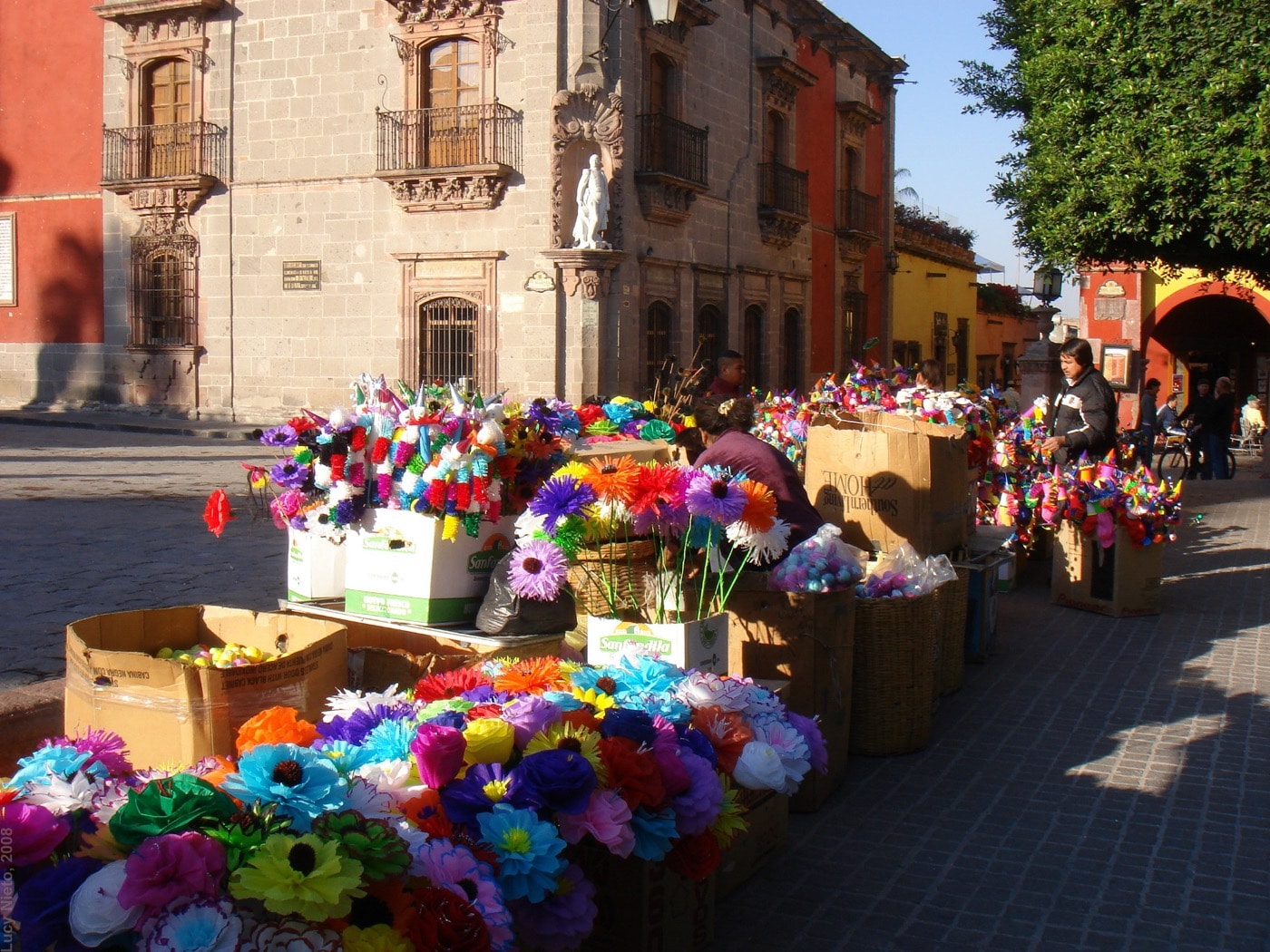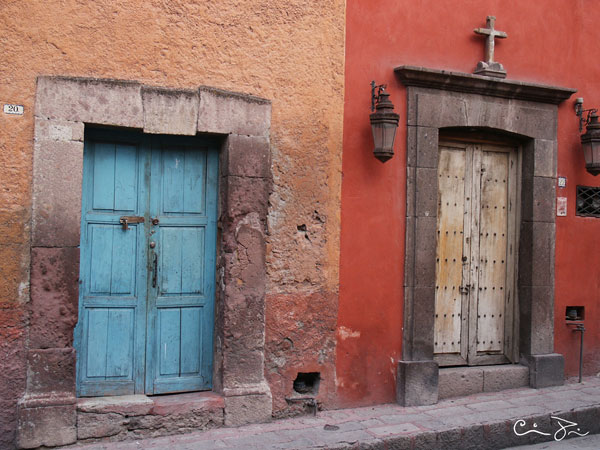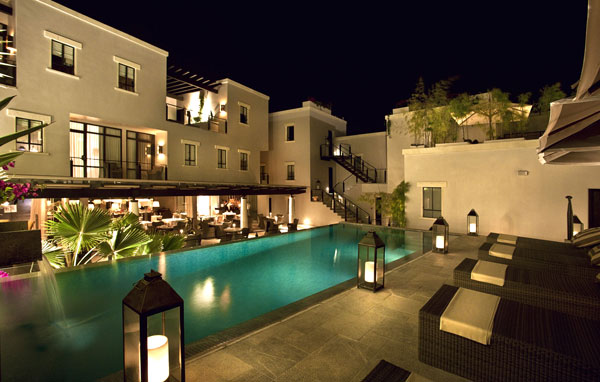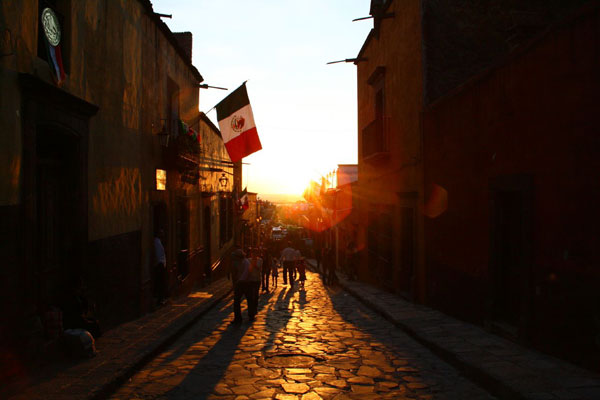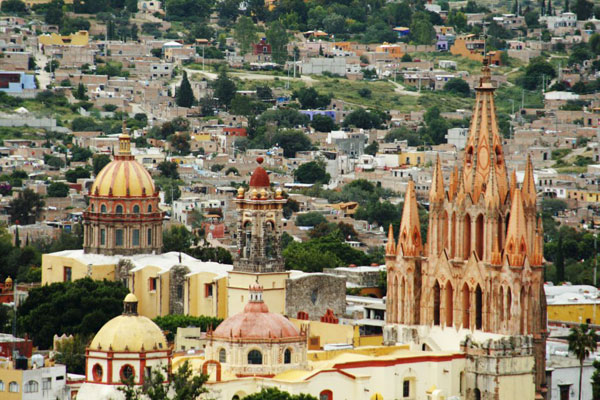After a morning of wandering the hilly, cobbled streets of San Miguel, I was quite tired and on the lookout for a nice spot for lunch. I ended up in the Jardin, the central square that is the heart and soul of this Spanish colonial town in central Mexico. I scanned the outdoor cafes for an empty table but none were available. While on Calle Cuna de Allende, one of the many streets fanning out from the Jardin, I paused at a restaurant sign and peeked in the doorway but saw nothing save a narrow staircase. I hesitated because the steep streets certainly take a toll on the legs but my growling stomach urged me onward. Once on the first floor, a hostess cheerily pointed to an even narrower and steeper staircase. Hmm. I continued climbing and once I reached the top, my eyes widened and my mood brightened. Before me was the most charming rooftop terrace I’d ever seen—a riot of fuchsia bougainvillea bushes, a few shaded tables and the piece de resistance, a reach out-and-touch-it view of the Parroquia, the massive 17th century cathedral whose dome dominates the skyline. I quickly ordered a margarita and settled in for a lovely, relaxing meal.
I had long heard of San Miguel de Allende (founded in 1542 by a Franciscan missionary) and put in on my bucket list of places to get to … eventually. But every time I went to Mexico, I couldn’t resist the siren song of the ocean—the Rivera Maya on the Caribbean Sea, Puerto Vallarta and Zihuatanejo on the Pacific. But as soon as I arrived for a long weekend and saw its stunning central Mexican highlands setting and colorful hacienda-style buildings I immediately realized I’d been wrong to put it off for so long. Expats, retirees and creative types have long been drawn to San Miguel, attracted not only by its temperate climate and beauty but also its authenticity—and residents are intent to keep it that way. There was a big hubbub when Starbucks wanted to open on the Jardin a few years ago and while it eventually succeeded its façade is very much in keeping with the square’s Old World vibe. But a town can’t stagnate and changes are inevitable and as it has suffered through the downturn in the economy and the tourism fallout from the chaos along Mexico’s border towns, new additions, whether they are hotels or restaurants, are much welcomed.
One of the most exciting newcomers is an upscale boutique hotel called Hotel Matilda, opened by Harold Stream, a Tennessee businessman and longtime San Miguel homeowner. Its stylish contemporary interiors are a departure from the traditional colonial-style b&bs. Materials such as local cantera stone and wood along with slate gray and metallic accents are used throughout and public spaces boast original artwork from cutting-edge names like Bosco Sodi and Nacho Rodriquez. Surrounding a central courtyard with a small infinity pool are the 32 minimalist rooms (many with balconies) spread among three low-lying buildings. On the terrace of Bar Matilda, under a huge jacaranda tree decorated with hanging lanterns, you can sip a glass of Casa Dragones tequila, a new artisanal tequila created by Mexico’s only female master tequilera, Bertha Nieves. Just off the courtyard is the restaurant, helmed by Chef Bernie McDonough, whose dishes incorporate vegetables grown at an organic farm just outside of town.
Another spot where chef McDonough finds fresh produce is the local food mercado or market where vendors sell everything from mangoes and papayas to corn and tomatoes as well as freshly made tortillas. At the makeshift food stalls, sample tacos and tamales for just a few pesos. Another popular market is Artisans’ Alley, three-blocks of tented stalls filled with Mexican crafts including decorative crosses,retablos (oil painting on tin or copper) and turquoise and silver jewelry. I found a pair of silver earrings I liked but the young seller, no more than 16, drove a hard bargain. She refused to haggle, which surprised me considering it is an accepted practice in Mexico and there were few customers that morning but I admired her resolve and gave in—I just had to have them. Funny how that is. There are also plenty of unique craft shops around town (where bargaining typically isn’t accepted) such as Ava Maria on Calle Relox for kitschy bags, t-shirts and design items with images of Frida Kahlo and Luche Libre. And just about every shoe store sells “combat cocktail sandals,” open-toe shoes with elastic straps created in San Miguel to protect your feet from those perilous cobblestones.
Back at the Matilda, I treated myself to a deep-tissue massage in the subterranean spa. In addition to four treatment rooms and an indoor/outdoor relaxation area complete with a fireplace, the 4,700 square foot space boasts a self-administered hammam ritual (exfoliation, body mask and aromatherapy steam) along with indigenous treatments including a “tres leches” wrap and other therapies incorporating coffee, cocoa and mint. Since my visit, the spa has opened an exclusive space at the Punte Verde hot springs (a 15 minute drive from town) called Spa en Vivo, where hotel guests can enjoy a massage and yoga before or after soaking in the mineral-rich hot springs called balnearios. After an afternoon of pampering, I was ready for a night on the town so I headed back to the Jardin, alive with mariachi bands, teens making eyes at each other, older folks sitting on a bench gossiping, festive wedding parties passing through to locations unknown. One of my favorite places to catch the sunset, people watch and sip a Modelo beer was La Azotea, a bustling rooftop bar frequented by hip locals and weekenders from Mexico City. Yes, it is reached by a series of nondescript staircases but I quickly learned that although San Miguel is intriguing on the surface it becomes downright intoxicating as you dig deeper.
The area code for Mexico is 52.
*Most US visitors fly into the Leon/Guanajuato airport and drive 90 minutes to San Miguel.
Where to Stay:
Hotel Matilda – this upscale boutique hotel on a quiet side street a few blocks from the cathedral has 32 rooms with white-on-white décor and design accents such as leather headboards, marble floors and black-and-white photos of San Miguel. Aldama No. 53, 415-152-1015, www.hotelmatilda.com
Hacienda de Guadalupe – just a half block from the Jardin, this new hacienda-style hotel is located in a former convent. The rooms feature high-end local crafts, terracotta tiled floors and sisal rugs. On the ground-floor is a restaurant and bar with specialty cocktails.
Hidalgo No. 4, 415-121-0700, www.hotelhaciendadeguadalupe.com
Rosewood San Miguel de Allende – Another newcomer to the lodging scene, this property is part of the Dallas-based luxury Rosewood chain. In addition to 67 rooms with wood-beamed ceilings and tin-framed mirrors, there’s the Sense Spa and the rooftop La Luna tapas bar. Nemesio Diaz No. 11, 415-152-9700, www.rosewoodsanmiguel.com
Where to Eat and Drink:
Restaurant Matilda
Mushroom soup, manchego cheese-and-caramelized onion quesadillas and mole-glazed beef short ribs are just a few of the delicious dishes created by Chef Bernie McDonough. Dine in the main room or on the breezy terrace overlooking the pool. Aldama No. 53, 415-152-1015, www.hotelmatilda.com
La Azotea – a fashionable local crowd and hipsters from Mexico City make this rooftop space one of San Miguel’s busiest cocktail lounges. There are two bars, one indoor with comfy couches and chairs and the other on the terrace facing the cathedral.
Umaran No. 6, 415-152-4977, www.azoteasanmiguel.com
La Posadita – follow the narrow steps from the street and you’ll be treated to one of San Miguel’s best cathedral views from its charming rooftop terrace. Enjoy the traditional Mexican dishes (enchiladas, cochinita pibil) and potent margaritas. Cuna de Allende No. 13, 415-154-7588
1826 Restaurant & Bar – located at the Rosewood property, 1826 serves modern Mexican dishes in the main dining room with wood accents and a fireplace and garden-facing terrace. There’s also a well-stocked Tequila Bar complete with a tequila sommelier. Nemesio Diaz No. 11, 415-152-9700,www.rosewoodsanmiguel.com
What to See and Do:
Parroquia- the cathedral is visible from just about every vantage in town and its bells peal every 15 minutes. At night it’s beautifully floodlit. During the day, take a peek inside to see glass chandeliers, vaulted ceilings, frescoes and a large organ.
Jardin – San Miguel’s zocalo or main square, the Jardin has been the center of town since 1737. Day or night there’s always something going on—vendors selling tamales, tourists snapping photos and locals tapping away on laptops now that it has WiFi.
Artisans’ Alley – be prepared to spend a few hours at this centrally located market that spans three blocks. You’ll find all manner of Mexican crafts made from tin, wood and glass as well as clothing, silver jewelry and other knickknacks.

